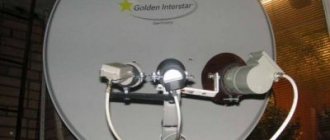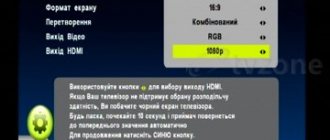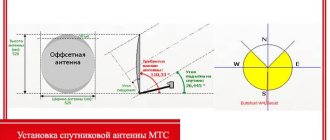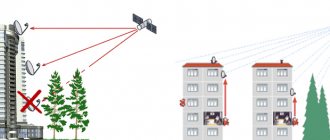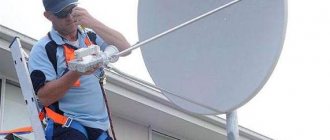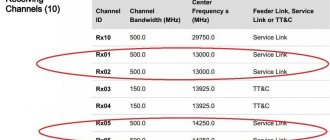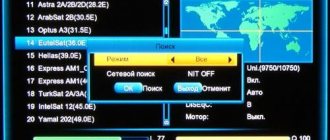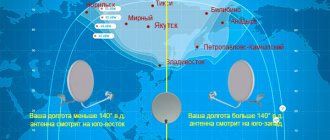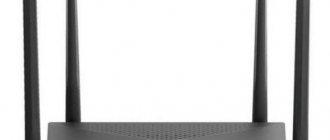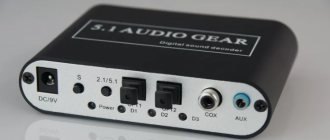Perhaps the converter installed on the satellite dish has an excessively high noise figure. Or the user decided to save money and bought a cheap cable with low bandwidth. Maybe, in addition to everything else, the satellite receiver itself has poor input sensitivity (the “input signal level” parameters are too low), for example, the first receiver I got was just like that.
Now, based on the above, we can sum up the following: as you now understand, it is theoretically simply not realistic to accurately select the required diameter of a satellite dish. You will have one hundred percent confidence only when you check everything in practice. Therefore, we will proceed from the parameters provided by the satellite provider itself.
Unfortunately, we cannot change the power of the signal coming from the satellite, but... we can learn how to correctly select the configuration of satellite equipment. In other words, we need to be able to understand certain parameters of individual elements of satellite equipment, and so that they are no worse than certain standards. And as practice has shown, in most cases, this will be more than enough.
…
Next, we will look at the main types of satellite antennas used in satellite reception.
On the pages of this section, we dealt with the structure and operating principle of a satellite dish (satellite dish). There they considered a parabolic asymmetric antenna with a shifted focus, such as Offset, that is, an offset satellite antenna (Fig. 1).
Offset satellite dish
(parabolic asymmetric)
There is another very common type that you may also encounter, this is a direct-focus parabolic symmetrical satellite antenna (Fig. 2), or simply a direct-focus antenna. They differ both in design and in the principle of signal transmission.
Direct focus satellite dish
(parabolic symmetric)
According to the principle of operation, these two satellite antennas differ in the direction of the signal reflected from their reflector, that is, from the mirror of this antenna itself.
With an offset satellite antenna, the signal coming from the satellite hits the inner part of the spherical mirror of the antenna at a certain angle (Fig. 3). After being reflected, the signal is focused onto the converter feed located below.
Signal flow at an offset satellite dish.
It turns out that the focus of offset satellite antennas is located to the side, that is, as if shifted to the bottom of the structure. That's why they are called asymmetrical (no symmetry).
With a direct focus satellite antenna, the signal coming from the satellite is focused at the diametrical center of a spherical mirror. That is why it is called symmetrical (Fig. 4).
Signal transmission at a direct-focus satellite dish.
As can be seen in the images above, the significant difference between offset and direct focus satellite antennas is, of course, their design. But this is just the technical side. The most significant difference will be their position.
The direct-focus antenna, as if lifted its “nose” to the top, and looks strictly in the direction of the satellite. An offset antenna has some inclination. From the side it seems that she is looking down, but she is catching a reflection from the ground. But... as it approaches the equator, instead of this tilt, its mirror will already rise.
Before purchasing a satellite dish, you will need to make a choice which type of design to choose, or which antenna design is best to use, specifically for your case. Therefore, next we will consider what advantages and disadvantages offset and direct focus satellite antennas will have.
Each of these types of satellite dishes has its own pros and cons. A number of important advantages and disadvantages of offset and direct focus satellite antennas include:
1. With an offset satellite dish, the focus of the signal reflected from the reflector is shifted to the side. This has a significant and positive effect on its unhindered passage to the converter irradiator. But with a direct-focus antenna, the passage of the signal is impeded by both its stands holding the converter and the converter itself.
2. Under different climatic conditions, be it rain or snow, an offset satellite dish will have a significant advantage. This is explained by the position of the reflector itself. When viewed from the side, the reflector of an offset antenna acts like a visor, like, for example, on an open-type telephone booth. Therefore, precipitation does not fall on the reflected surface of the antenna itself, but only on its rear part (Fig. 1).
Types of satellite dishes
The most common satellite antennas are parabolic antennas (the term “satellite dish” is usually meant in common parlance), which come in various types and sizes.
Direct focus (axisymmetric) antenna
A direct-focus (axisymmetric) antenna is an antenna with an aperture in the form of a paraboloid of revolution. The diameter of the antenna determines its gain and, accordingly, the stability of receiving satellite signals. Depending on the geostationary satellite used, the diameters of the receiving antennas can be from 0.9 m to 3.7 m. Feeds are installed at the focus of the parabolic mirror. Typically, such antennas are used to receive signals in the C-band and Ku-band.
Parabolic antennas are also used to transmit signals to satellites. Low-noise amplifiers (LNAs) with low noise levels and converters are attached to the satellite antenna feeds, which makes it possible to amplify high-frequency signals directly after the feeds and convert them into intermediate frequency signals. Intermediate frequency signals are transmitted through cables connected to converters for further amplification and detection.
Offset antenna
The offset antenna is the most common in individual satellite television reception, although other principles for constructing terrestrial satellite antennas are currently used. The offset antenna is an asymmetrical cutout from a paraboloid of rotation with a feed at the focus of the paraboloid. The focus of such a segment is located below the geometric center of the antenna. This eliminates the shading of the useful area of the antenna by the feed and its supports, which increases its efficiency with the same mirror area as an axisymmetric antenna. In addition, the feed is installed below the center of gravity of the antenna, thereby increasing its stability under wind loads.
The offset antenna mirror is mounted almost vertically. Depending on the geographic latitude, the angle of its inclination varies slightly. This position prevents precipitation from collecting in the antenna bowl, which greatly affects the quality of reception. When viewed through the light, the antenna does not appear as a circle, but as an ellipse, elongated vertically. The dimensions of an offset antenna are usually given in terms of gain equivalent to the direct focus ones. If this size is the same horizontally, then vertically it will be approximately 10% larger.
Typically, offset antennas are used to receive C and Ku-band signals (in linear and circular polarization). However, signal reception in the Ka-band, as well as combined, is also possible.
Toroidal antenna
The technology for constructing and producing toroidal antennas makes it possible to receive up to 16 satellites simultaneously within 55 degrees, while each converter will be directly in the focus of the satellite to which it is directed. Reliable reception is ensured by the use of a toroidal formula for satellite signal reception when constructing an antenna, which is realized by using two reflectors (mirrors). Thus, the signal from the main reflector is reflected into the additional one and then directly into the converter feed.
The presence of two mirrors and a meticulous approach to the design of reflective surfaces are the main advantages of a toroidal antenna over a conventional offset antenna. Using these advantages, the user is able to build a multi-system without the use of rotating devices. Thus, getting rid of such disadvantages of the rotary system as: slow switching between channels broadcast from different satellites, which is associated with reorientation of the antenna, as well as the impact of natural phenomena on the performance of the drive (freezing of mechanisms in winter, failure due to wind load on the antenna etc.).
The toroidal antenna combines the possibility of a one-time rigid installation, both in a conventional azimuth scheme, which does not require the use of an actuator or a positioner, and multiple installation of up to 16 converters on the antenna. Thus, the speed of switching channels from different satellites is equal to the speed of switching channels from one satellite. If you want to view channels from a new satellite, then to receive it you just need to place an additional converter on the antenna mounting rod.
Flat Antennas
Flat antennas are no longer exotic, although they cannot be called widespread and used either. Every amateur (there is no talk of professionals) of satellite television has probably seen a flat antenna at least once - if not “live,” then at least in a picture.
But, probably, not everyone who has seen it more or less clearly understands what is what in this flat antenna and how, in fact, signals are received.
As for spherical antennas, it is likely to assume that even the name - “spherical antennas for satellite television” - can cause confusion among readers. Well, let's briefly talk about everything in order.
Flat satellite dish.
In the Western satellite press, the issue is covered approximately as follows and in this vein: “It is clear that parabolic antennas - direct focus and offset - are very trivial and have long set everyone’s teeth on edge. They are bulky - if not physically, then certainly visually; They accumulate snow and rain (this mainly applies to direct-focus ones), and in general they begin to become obsolete.”
Flat satellite antennas.
Under the influence of such maxims, one inevitably gets the impression that it is precisely these reasons, plus one more, the most important one - the dissatisfaction of homeowners with the appearance of their houses, hung with antenna dishes - that encourage engineers in all countries to rack their brains over the best technical implementation of the idea of a flat satellite dish. At the same time, it should also be taken into account that in size a flat antenna is in no way inferior to parabolic antennas - for example, an antenna measuring 60x60 cm corresponds in its reception parameters to an offset antenna with a diameter of 60 cm.
The main advantages of flat antennas include:
- high manufacturability, and therefore high reproducibility of parameters;
- reduction in wind loads by approximately 10-20% compared to mirror antennas;
- possibility of electrical control of the directional pattern;
- ease of transportation, storage and installation.
Flat antennas are created on the basis of strip emitters connected in parallel and thus forming a flat antenna array capable of receiving electromagnetic signals. The characteristic dimensions of the strip emitters are a multiple of the wavelength of the received signal; all these small elements are in-phase connected to the collecting busbars, brought to the center of the antenna, where the converter is located. Signals can be received, roughly speaking, from all possible directions, or, in other words, flat antennas have a large opening angle and a wide radiation pattern with significant side lobes. Thus, the directivity of such antennas is slightly lower than that of mirror antennas of the corresponding area.
Spherical satellite dish
Let's say right away, without intriguing the reader for long, that these spherical antennas represent an elementary lens. Yes, a centrally symmetrical lens (CLL) made of dielectric, focusing the signal from the satellite, as usual, onto a converter located at a point on the focal plane concentric with the LCL. Here it is appropriate to draw - for greater clarity - an analogy with the human (and not only human) eye, which creates on the retina an image of objects falling into the field of view. And a person’s field of vision is quite wide, because we see not only what is right in front of us. Thus, the visual angle of one eye horizontally is 940, and vertically - 770.
And the peculiarity of spherical antennas, their difference from mirror or flat ones, is precisely that they are multi-satellite, i.e. One such antenna can immediately, simultaneously, receive signals from different satellites located at different points of the geostationary orbit and even in different orbits - in addition to geostationary ones, also in inclined, highly elliptical ones. And note - no positioners or actuators! But, of course, you must remember to place the converters for each selected satellite in the appropriate position in the “orbit” of the antenna-sphere. Precisely “orbit”, because this antenna - with mounting hardware and installed converters - looks like some planet, Saturn, for example, with rings, or the Earth with the same “our sheep” - I mean, of course, satellites...
One spherical antenna with a diameter of one to one and a half meters can replace seven to eight parabolic antennas of the appropriate sizes, covering a sector of up to 90-125 degrees in azimuth and 40-60 degrees in elevation.
Multifocal satellite dish
A satellite multifocal antenna from the Spanish manufacturer Telesystem designed to receive several satellites in a segment of up to 40* degrees. A “multi-focus” antenna is an alternative to a rotary receiving system - it is more reliable, easier to set up, works with all receivers, and in addition, switching channels from different satellites occurs instantly. An example of installing this antenna would be receiving a signal from five satellites:
Features of operation
Sometimes the antenna signal is too weak. Then you need to check whether the mirrors of the plate have been deformed so that they resemble a figure eight. It is important that if you look at the reflector parallel to the opening, the edges merge into a single line.
If the receiver does not work well, you need to buy a new one. Sometimes you should purchase a converter with a lower noise figure. Sometimes you can buy another copy of the same batch. It is important that the converter feed is in accordance with the f/d parameter of the reflector.
Specification
You can check the focal length as you move the converter closer and further away from the reflector.
Interesting fact. Twice a year, at the autumn and spring equinoxes, the sun appears in line with the satellite and the receiving antenna. Then solar radiation ends up in the converter along with the satellite signal. This degrades the signal quality. This may damage the equipment. Therefore, it is necessary to place a cardboard or polyethylene (opaque) screen in front of the irradiator in time.
How to choose a satellite dish
The satellite “dish” in the minds of the “broad sections of the population” rightfully personifies the entire satellite receiving system. Of course, in fact, any satellite television system consists of many parts, although the antenna is quite objectively almost its most important part. And at the very least, it’s hard not to agree that the antenna is the largest and most visible element of the receiving system.
Before we talk about how to choose a satellite dish, it is necessary to determine: to work as part of which receiving satellite system it is intended. That is, when choosing a satellite dish (as well as other components of the receiving system), you first need to answer several questions:
- In the coverage area of which satellites do you live, that is, which satellites can you basically receive?
- What channels are you interested in and which satellite do you want to watch?
- Is it possible to position the antenna so that local “objects” do not block the direction to the satellite?
- Do you want to watch one or more satellites?
- What are the financial resources that you want to invest in this “enterprise”?
The satellite antenna (the mirror itself) is designed to focus a parallel beam of radio waves emitted by the satellite onto the converter feed. The antenna is part of a paraboloid of rotation, since it is this shape that provides excellent focusing of a parallel beam of radiation.
Television signals are transmitted from satellites in the Ku (~11 GHz) and C (~4 GHz) bands, that is, the received signals have a wavelength of 27 and 75 mm, respectively. That is why any obstacle (dense clouds, snow, rain) on the path between your antenna and the satellite will weaken the signal and may completely exclude (if this obstacle is trees, buildings, etc.) the possibility of receiving satellite television programs.
Prime focus antenna. The apparent direction to the satellite coincides with the perpendicular to the antenna opening plane
In principle, if you have not yet forgotten what a sine is, and you can find the place where you are on a geographic map, you can determine the apparent direction to the satellite (azimuth and elevation) (Fig. 1) using formula 1.
Now all that remains is to take a compass and make sure that there are no obstacles blocking the satellite in this direction (trees, neighboring houses or, for example, a factory chimney).
a = arctg ( ( tg[G1-G2] ) / sin[W] ) ( cos[G1-G2] * cos[W]-0.1509 ) sqrt ( sin(G1-G2) + cos(G1-G2) * sin (W) )
Where:
- a—azimuth;
- b—elevation angle;
- G1 is your geographic longitude;
- G2 - longitude of the location of the satellite you are interested in in orbit (western with a minus);
- W is your geographic latitude.
For example: for Astra [19.2° E (East longitude)] G2=19.2°, and for Intelsat 601 [27.5° W (West longitude)] G2= -27.5°.
It should be taken into account that often not all satellite channels are equally good. In addition, it is necessary to select the antenna size with some margin so that slight signal deterioration, caused, for example, by atmospheric phenomena, does not lead to a strong deterioration of the television “picture”. Therefore, the safest method is to contact a company that installs satellite systems in your city and find out how well the channels you are interested in are received in your region and what antenna diameter is required for this.
Perform Pre-Setup Preparations
The satellite dish must be assembled and installed in the manner specified in the instructions supplied with it. Then you prepare and configure the cable included in the kit yourself. Initially, you need to strip the top layer of insulation using pliers. As a result, a screen will be detected, which consists of small wires. They bend onto the cable. The screen made of foil must be removed. Its core is located under a protective coating, the lower part of which is exposed. It needs to be cleaned of the remaining coating and the F-connector put on it.
The photo shows the installation of a satellite dish
Shapes of satellite dishes
Antennas are shaped like prime focus and offset (off-set).
Straight focus ones are a “classic” round “plate”. The converter is mounted in the center using several (usually two or three) spokes. In this case, the converter and mounting spokes obscure part of the reflective surface of the mirror, which naturally leads to a decrease in the utilization factor of the antenna surface. However, as the diameter increases, this effect becomes less significant. In winter, ice and snow easily freeze on the mirror, which greatly impair reception. Offset (Fig. 3) antennas can be very easily distinguished, since their focus (the place where the converter is placed) is shifted down from the center of the mirror. It is precisely because of the shifted focus that when setting up it is necessary to take into account that the direction to the satellite for offset antennas is higher than the perpendicular to the antenna plane by a certain angle. For most offset designs, this angle is ~25-27°. Therefore, offset antennas are mounted almost vertically, snow does not stick to them and water does not accumulate, the converter and mounting elements do not obscure the antenna.
Due to these features, offset antennas are very popular with mirror diameters up to ~1.5 m. For larger diameters, preference is given to direct-focus antennas.
Introduction
After you have chosen which satellite Internet provider you are going to work through, it’s time to start choosing a satellite dish, or, as they are used to calling it, “dishes”. In reality, choosing a satellite dish is a very simple matter. You don't need to know any formulas and don't need any calculations. You can generally rely on the sellers to select an antenna for you, but it’s better to make the choice yourself. Today, some companies offer ready-made kits for satellite Internet. For example, they sell kits for Europe OnLine, consisting of a Technisat SkyStar 2 DVB card, a satellite dish and a subscription to use the service for several months. The seller of such a kit, as a rule, undertakes to install an antenna for you, configure the software and deliver the satellite Internet, as they say, on a turnkey basis. When buying such kits, you overpay significantly, because satellite Internet in Russia is still the domain of organizations or wealthy private individuals, and therefore the price of such kits is increased. Moreover, at first glance it may seem that the prices are real, because a DVB board and dish will cost almost the same as in other stores, but the cable and installation work will cost you more than if you called another specialist, and the cable We’d buy it ourselves, but we’ll talk about that later. For now, let's move on directly to the choice.
Types of satellite antenna suspension
In addition to the size and shape of the mirror, a very important parameter is the type of antenna mounting. The suspension can be azimuthal or polar. Azimuth - as a rule, a fixed suspension, the antenna is tuned to a single satellite and is rigidly fixed to the mounting bracket. To receive another satellite, the antenna must be completely reconfigured. Simple and cheap pendant.
Polar is a much more complex suspension in design and configuration (see T/S No. 12, 1997, p. 42) and, accordingly, more expensive. Provides the ability to receive several satellites located in different orbital positions by rotating the antenna only around one vertical axis.
Most often, offset antennas have a fixed azimuthal suspension, while direct-focus antennas have a polar one. In addition, even if you want to receive several satellites, for which a 1.2 m antenna is sufficient, it is better to put 1.8 m or at least 1.5 m in the polar system. Some reserve will not hurt. Recently, offset antennas with polar suspension and sizes up to 1.6 m are increasingly appearing. Unfortunately, there are not many “normal” Western samples. Russian craftsmen have learned to attach “normal” offset antennas with azimuthal suspension to homemade polar suspensions, but the financial gain is insignificant, although for receiving 2-3 clearly visible satellites this, it seems to us, is a good solution.
see also
- setting up and pointing a satellite dish,
- satellite dishes, satellite dish,
- satellite dish direction, direction units,
- satellite antenna characteristics,
- satellite antennas choice,
- purpose of satellite antennas, use of satellite antennas,
- parabolic dish antenna, multi-mirror antenna,
- device of a satellite dish, principle of operation of a satellite dish,
- Satellite connection
- Satellite television
- Satellite radio
- Satellite phone
- Satellite Internet
- Satellite modem
- Satellite converter
- BUC
- antenna
Unfortunately, it is not easy to provide all the knowledge about the types of satellite antennas in one article. But I tried. If you show interest in revealing the details, I will definitely write a sequel! I hope that now you understand what types of satellite antennas are and what all this is needed for, and if you don’t understand, or have any comments, then don’t hesitate to write or ask in the comments, I will be happy to answer. In order to gain a deeper understanding, I strongly recommend studying all the information from the Television category. Theory. Satellite
Satellite antenna material
The most popular material for the manufacture of satellite antennas is aluminum, it is lighter than steel and is not subject to corrosion, but it is soft, and if handled carelessly (this especially applies to large diameter mirrors >1.2 m), aluminum antennas are easily deformed, which has a very detrimental effect on their characteristics.
When purchasing an antenna, be sure to pay attention to the presence of defects and distortions on the antenna surface. Wrinkled mirrors and those that have been “driven” by a screw work much worse than normal ones.
Steel antennas are stronger, cheaper (though not much), but heavier and subject to corrosion, which reduces their reflective properties. Therefore, when purchasing a steel mirror, you should pay attention to the quality of the paint.
Plastic mirrors are lightweight, but snow easily sticks to them. Over time, such antennas are subject to severe deformation under the influence of the environment (sudden temperature changes, ultraviolet radiation).
Mesh antennas are resistant to wind loads and are often indispensable when installed at high altitudes and in windy areas. In addition, they spoil the “landscape” much less, especially in historical areas. Unfortunately, they exhibit poorer performance on Ku-band signals (the most popular today) and therefore require a larger antenna diameter than a solid mirror to provide the same quality reception. Since mesh antennas are not produced in Russia, they are usually more expensive than their solid “colleagues”.
For a private home
Although private houses come in different sizes, the average house occupies about 100 square meters. Based on this, we can assume that there will be at least two TVs in the house.
Providers have the following kits for two modern TVs:
- Tricolor TV FULL HD set for 2 TVs. It includes a Twin converter, two receivers, GSE501 and GS C591, connected to each other (wired or via Wi-Fi). Using the kit you can watch high definition channels. The range of TV channels is huge, suitable for people of any category. Price: 10,500 rubles.
- NTV Plus set for 2 TVs. With it you can watch TV on two devices independently of each other. A converter with two outputs is connected to the satellite dish and two cables go from the antenna to the receivers. Each TV has its own NTV-PLUS710HD set-top box. You can watch SD and HDTV channels. Price 13,700 rubles.
- MTS also includes 2 independent cables for EKT DSD 4614i set-top boxes for 2 TVs. There are few UHD channels, but HD is shown well. There are discounts and promotions for the first connections to packages. Price 11850 rubles.
For the dacha
Choosing a satellite dish for your dacha is not difficult. The house usually has one TV, and not the latest model. Therefore, to connect, a very ordinary set with a receiver that produces SD and HD quality TV channels is enough.
- An inexpensive set of satellite Tricolor TV with a DTS 54 prefix. You can connect both an old and a new TV. 4K viewing is not implemented. An excellent option for rural areas. Price 7500 rubles.
- An inexpensive NTV set with an NTV-PLUS 710HD receiver allows you to connect and watch a lot of TV channels, including the “Sports”, “Premiere Movies”, “Popular Science” and others packages. Price 8990 rubles.
- MTS TV “standard” with the EKT DSD 4614i set-top box even works with UHD TV. There are options for recording TV programs onto a flash drive or external drive. Implemented support for H.265/AVC. An excellent price for the village - 7,000 rubles.
To the apartment
Which satellite dish to choose for an apartment is of interest to many residents of large cities. Usually, they settle on a satellite dish for one TV. If you need to connect two TVs, pay attention to “for home” kits. For an apartment, we will consider satellite TV with receivers that can record programs.
- The Tricolor TV set with GS E502 is equipped with a 500 GB hard drive. Using the drive, you can easily record programs. In addition, the shift option is implemented - rewind or pause a TV show. Price 11,730 rubles.
- NTV Plus has a similar set with recording capabilities. It comes with a Thomson DSI 8020 HDTV receiver for recording shows and movies. Recording can be done using a timer. The size of the built-in hard drive is 500 GB. Price: 10,490 rubles.
- MTS Premium does not have a built-in hard drive, but the Openbox AS1 receiver that is present runs on Android. Because of this set-top box, all sorts of options are available, including access to film libraries and IPTV, viewing from connected media and recording television content on them. Price: 13140 rubles.
In general, you can select and configure the kit yourself.
Useful: How to install a satellite dish yourself
How to install a satellite dish correctly
When purchasing an antenna, you need to pay special attention to the reliability of the suspension elements and the bracket on which it will be mounted, as well as the fasteners. This is especially important if the antenna will be installed in a high or windy location. The bracket is usually secured using special self-wedging bolts. It is worth paying attention to the size of the bracket: its design should allow you to point the antenna in the desired direction (without resting the edge of the mirror against the wall), this is especially important for polar systems configured to receive several different satellites.
Advantages and disadvantages
In general, satellite television has its positive and negative sides.
The advantages include:
- High-quality and stable signal;
- High resolution TV channels;
- Implementation of access to television in remote or hard-to-reach areas;
- A huge number of TV channels (via satellite, TV operators offer to connect many channels of different directions).
The disadvantages are:
- The price for equipment is high;
- Paid monthly subscription options;
- There may be interference in bad weather.
If you do not purchase an antenna from a provider, then there will be restrictions on many channels. They will be encrypted.
